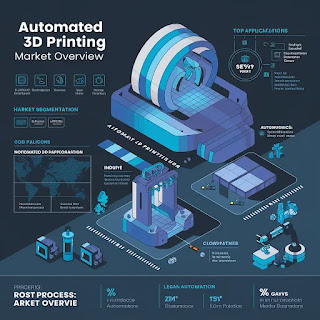Revolutionizing Manufacturing: The Rise of Automated 3D Printing
Automated
3D printing is rapidly transforming from a tool for prototyping to a key
technology in mass production. By integrating robotics, artificial intelligence
(AI), and advanced software, automated 3D printing is enabling manufacturers to
achieve faster production, greater precision, and enhanced efficiency. As
industries embrace digital transformation, automated additive manufacturing is
becoming a central pillar of Industry 4.0.
Explore the full report - https://futuremarketanalytics.com/report/automated-3d-printing-market/
Market Outlook and Growth Potential
The global automated 3D printing market is experiencing
remarkable growth. Industry estimates suggest that the market, valued at just
under $3 billion in 2025, could surpass $13 billion by 2030. This reflects a
compound annual growth rate (CAGR) of over 30%. Such rapid expansion is driven
by rising demand in sectors like automotive, aerospace, healthcare, and
consumer goods, where companies are seeking faster, cost-effective, and more
flexible production processes.
While market forecasts vary, depending on the scope of
technologies and services included (such as hardware, software, and
post-processing automation), the consensus is clear: automated 3D printing is
on a steep upward trajectory globally.
Drivers of Market Growth
Several key factors are fueling the expansion of automated
3D printing:
- Smart
Manufacturing and Industry 4.0 Adoption
Manufacturers are increasingly implementing automation technologies, including robotics and AI, to handle material loading, print monitoring, post-processing, and quality control. This shift reduces human error, increases uptime, and enables 24/7 production. - Demand
Across High-Impact Sectors
- Automotive:
3D printing accelerates prototyping and tool development, enabling faster
design iterations and cost savings.
- Aerospace:
Lightweight components, complex geometries, and part consolidation are
possible through additive manufacturing, reducing assembly time and
weight.
- Healthcare:
Customized implants, dental devices, and surgical tools are produced with
greater accuracy and patient-specific design.
- Sustainability
and Reduced Waste
Additive manufacturing builds parts layer-by-layer, using only the necessary material. This approach minimizes waste compared to traditional subtractive methods, supporting sustainability goals. - Customization
and On-Demand Production
The technology enables cost-effective low-volume production and custom designs, reducing inventory requirements and shortening supply chains.
Challenges in the Market
Despite its advantages, automated 3D printing faces several
hurdles:
- High
Capital Investment: Industrial-scale systems and supporting automation
require substantial upfront costs, making adoption challenging for small
and medium enterprises.
- Material
and Speed Limitations: While improving, the range of printable
materials and overall production speed still lag behind some traditional
manufacturing methods.
- Skilled
Workforce Requirement: Integrating automated 3D printing demands
expertise in CAD design, robotics, and process management, creating a need
for specialized training.
- Regulatory
Compliance: Industries like aerospace and healthcare require rigorous
certification processes for 3D printed parts, which can slow adoption.
Future Opportunities
Looking ahead, innovations are set to unlock new potential:
- Post-Processing
Automation: Robotics for depowdering, cleaning, and surface finishing
are reducing manual labor and improving consistency.
- AI-Enhanced
Quality Control: Real-time monitoring systems are helping detect and
correct defects during the printing process, minimizing waste and ensuring
high quality.
- Distributed
and Swarm Printing: Networked printers or robotic printer swarms offer
scalability and localized production, reducing logistics costs and lead
times.
Global and Regional Momentum
Globally, countries are investing in automated 3D printing
to strengthen manufacturing resilience. For example, India is promoting
additive manufacturing to drive innovation, job creation, and affordable
housing solutions through initiatives supporting startups and industrial
adoption.
Automated 3D printing is no longer just a futuristic
concept—it’s reshaping manufacturing today. As automation technologies advance,
this sector promises smarter, more sustainable, and agile production across
industries. The future of manufacturing is being built layer by layer, and
automated 3D printing is at the heart of this transformation.




Comments
Post a Comment